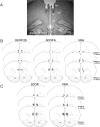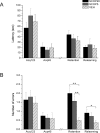Differential effects of muscarinic receptor blockade in prelimbic cortex on acquisition and memory formation of an odor-reward task
- PMID: 17848501
- PMCID: PMC1994078
- DOI: 10.1101/lm.597507
Differential effects of muscarinic receptor blockade in prelimbic cortex on acquisition and memory formation of an odor-reward task
Abstract
The present experiments determined the consequences of blocking muscarinic cholinergic receptors of the prelimbic (PL) cortex in the acquisition and retention of an odor-reward associative task. Rats underwent a training test (five trials) and a 24-h retention test (two retention trials and two relearning trials). In the first experiment, rats were bilaterally infused with scopolamine (20 or 5 microg/site) prior to training. Although scopolamine rats showed acquisition equivalent to PBS-injected controls, they exhibited weakened performance in the 24-h retention test measured by number of errors. In the second experiment, rats were injected with scopolamine (20 microg/site) immediately or 1 h after training and tested 24 h later. Scopolamine rats injected immediately showed severe amnesia detected in two performance measures (errors and latencies), demonstrating deficits in retention and relearning, whereas those injected 1 h later showed good 24-h test performance, similar to controls. These results suggest that muscarinic transmission in the PL cortex is essential for early memory formation, but not for acquisition, of a rapidly learned odor discrimination task. Findings corroborate the role of acetylcholine in consolidation processes and the participation of muscarinic receptors in olfactory associative tasks.
Figures




Similar articles
-
Muscarinic receptor blockade in ventral hippocampus and prelimbic cortex impairs memory for socially transmitted food preference.Hippocampus. 2009 May;19(5):446-55. doi: 10.1002/hipo.20530. Hippocampus. 2009. PMID: 19004013
-
Muscarinic cholinergic receptor blockade in the rat prelimbic cortex impairs the social transmission of food preference.Neurobiol Learn Mem. 2007 May;87(4):659-68. doi: 10.1016/j.nlm.2006.12.003. Epub 2007 Jan 12. Neurobiol Learn Mem. 2007. PMID: 17223581
-
D-cycloserine in prelimbic cortex enhances relearning of an odor-reward associative task.Behav Brain Res. 2010 Nov 12;213(1):113-6. doi: 10.1016/j.bbr.2010.04.016. Epub 2010 Apr 22. Behav Brain Res. 2010. PMID: 20399234
-
Behavioral pharmacology and biochemistry of central cholinergic neurotransmission.Adv Exp Med Biol. 1991;295:399-414. doi: 10.1007/978-1-4757-0145-6_23. Adv Exp Med Biol. 1991. PMID: 1663698 Review.
-
Role of cholinergic system on the construction of memories: taste memory encoding.Neurobiol Learn Mem. 2003 Nov;80(3):211-22. doi: 10.1016/s1074-7427(03)00061-3. Neurobiol Learn Mem. 2003. PMID: 14521864 Review.
Cited by
-
Effects of muscarinic receptor antagonism in the basolateral amygdala on two-way active avoidance.Exp Brain Res. 2011 Mar;209(3):455-64. doi: 10.1007/s00221-011-2576-4. Epub 2011 Feb 12. Exp Brain Res. 2011. PMID: 21318348
-
Enhancement of Drug Seeking Following Drug Taking in a Sexual Context Requires Anterior Cingulate Cortex Activity in Male Rats.Front Behav Neurosci. 2020 Jun 25;14:87. doi: 10.3389/fnbeh.2020.00087. eCollection 2020. Front Behav Neurosci. 2020. PMID: 32670029 Free PMC article.
-
Long-term memory, synaptic plasticity and dopamine in rodent medial prefrontal cortex: Role in executive functions.Front Behav Neurosci. 2023 Jan 11;16:1068271. doi: 10.3389/fnbeh.2022.1068271. eCollection 2022. Front Behav Neurosci. 2023. PMID: 36710953 Free PMC article. Review.
-
Muscarinic antagonists impair multiple aspects of operant discrimination learning and performance.Neurosci Lett. 2023 Jan 18;794:137025. doi: 10.1016/j.neulet.2022.137025. Epub 2022 Dec 15. Neurosci Lett. 2023. PMID: 36529388 Free PMC article.
-
The role of medial prefrontal cortex in memory and decision making.Neuron. 2012 Dec 20;76(6):1057-70. doi: 10.1016/j.neuron.2012.12.002. Neuron. 2012. PMID: 23259943 Free PMC article. Review.
References
-
- Aigner T.G. Pharmacology of memory: Cholinergic-glutamatergic interactions. Curr. Opin. Neurobiol. 1995;5:155–160. - PubMed
-
- Anagnostaras S.G., Murphy G.G., Hamilton S.E., Mitchell S.L., Rahnama N.P., Nathanson N.M., Silva A.J. Selective cognitive dysfunction in acetylcholine M1 muscarinic receptor mutant mice. Nat. Neurosci. 2003;6:51–58. - PubMed
-
- Aramakis V.B., Bandrowski A.E., Ashe J.H. Activation of muscarinic receptors modulates NMDA receptor-mediated responses in auditory cortex. Exp. Brain Res. 1997;113:484–496. - PubMed
-
- Boix-Trelis N., Vale-Martínez A., Guillazo-Blanch G., Marti-Nicolovius M. Muscarinic cholinergic receptor blockade in the rat prelimbic cortex impairs the social transmission of food preference. Neurobiol. Learn. Mem. 2007;87:659–668. - PubMed
-
- Broersen L.M., Heinsbroek R.P., de Bruin J.P., Uylings H.B., Olivier B. The role of the medial prefrontal cortex of rats in short-term memory functioning: Further support for involvement of cholinergic, rather than dopaminergic mechanisms. Brain Res. 1995;674:221–229. - PubMed
Publication types
MeSH terms
Substances
LinkOut - more resources
Full Text Sources
Medical
